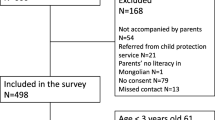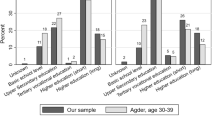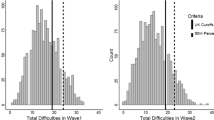Abstract
Background
The strengths and difficulties questionnaire (SDQ) is now one of the most commonly used instruments for screening child psychiatric morbidities. Psychometric studies in the West affirm its reliability and validity, but similar studies are scarce among non-Western populations. This is an important gap because cultural differences can influence how children’s behaviours are perceived and rated. This study explores the psychometric properties of the Chinese version of the SDQ among children in Hong Kong.
Method
The SDQ was translated into Chinese. A community sample of 3,722 students between 6 and 12 years were recruited by stratified random sampling from across the whole of Hong Kong. Comparison group consisted of 494 consecutive children attending a general child psychiatric clinic. SDQ and basic socio-demographic data were collected from parents and teachers. Reliability was determined by internal consistency and test–retest stability. Validity was assessed by the questionnaire’s ability to discriminate between community and clinic samples, and ROC curves. Cutoff scores and their sensitivity, specificity, positive predictive value and negative predictive value were calculated.
Results
Our results confirm the questionnaire’s reliability and validity. The total difficulties scale and hyperactivity subscale are potentially the most useful in discriminating between community and clinic children. The emotional subscale was relatively weaker, especially with respect to teachers’ ratings. Of note also is that our normative scores are significantly higher than those reported in the West, highlighting once again the importance of examining a questionnaire’s cultural applicability.
Conclusion
Our data support the use of the Chinese version of the SDQ, especially the total difficulties scale, as a screening instrument for psychiatric morbidities among children in Hong Kong.
Similar content being viewed by others
References
Goodman R (1997) The strengths and difficulties questionnaire: a research note. J Child Psychol Psychiatry 38:581–586
Vostanis P (2006) Strengths and difficulties questionnaire: research and clinical applications. Curr Opin Psychiatry 19(4):367–372
Goodman R (1999) The extended version of the strengths and difficulties questionnaire as a guide to child psychiatric caseness and consequent burden. J Child Psychol Psychiatry 40:791–799
Woerner W, Fleitlich-Bilyk B, Martinussen R, Fletcher J, Cucchiaro G, Dalgalarrondo P, Lui M, Tannock R (2004) The strengths and difficulties questionnaire overseas: evaluations and applications of the SDQ beyond Europe. Eur Child Adolesc Psychiatry 13(Suppl 2):II/47–II/54
Du Y, Kou J, Coghill D (2008) The validity, reliability and normative scores of the parent, teacher and self report versions of the strengths and difficulties questionnaire in China. Child Adolesc Psychiatry Mental Health 2:8. doi:10.1186/1753-2000-2-8
Matsuishi T, Nagano M, Araki Y, Tanaka Y, Iwasaki M, Yamashita Y, Nagamitsu S, Iizuka C, Ohya T, Shibuya K, Hara M, Matsuda K, Tsuda A, Kakuma T (2008) Scale properties of the Japanese version of the strengths and difficulties questionnaire (SDQ): a study of infant and school children in community samples. Brain Dev 30:410–415
Hawes DJ, Dadds MR (2004) Australian data and psychometric properties of the strengths and difficulties questionnaire. Aust N Z J Psychiatry 38(8):644–651
SDQ (2008) Information for researchers and professionals about the strengths and difficulties questionnaires. Avaliable from http://www.sdqinfo.com/bb2.html
SDQ (2008) Information for researchers and professionals about the strengths and difficulties questionnaires. Available from http://www.sdqinfo.com/bb1.html
Leung PWL, Hung SF, Ho TP, Lee CC, Liu WS, Tang CP, Kwong SL (2008) Prevalence of DSM-IV disorders in Chinese adolescents and the effects of an impairment criterion: a pilot community study in Hong Kong. Eur Child Adolesc Psychiatry 17:452–461
Goodman R (2001) Psychometric properties of the strengths and difficulties questionnaire. J Am Acad Child Adolesc Psychiatry 40(11):1337–1345
Bourdon K, Goodman R, Rae D, Simpson G, Koretz D (2005) Strengths and difficulties questionnaire: US normative data and psychometric properties. J Am Acad Child Adolesc Psychiatry 44(6):557–564
Leung PWL, Kwong SL, Tang CP, Ho TP, Hung SF, Lee CC, Hong SL, Chiu CM, Liu WS (2006) Test–retest reliability and criterion validity of the Chinese version of CBCL, TRF, and YSR. J Child Psychol Psychiatry 47(9):970–973
Achenbach TM, McConaughy SH, Howell C (1987) Child/adolescent behavioural and emotional problems: implications of cross-informant correlations for situational specificity. Psychol Bull 101(2):213–232
Mullick MSI, Goodman R (2001) Questionnaire screening for mental health problems in Bangladeshi children: a preliminary study. Soc Psychiatry Psychiatr Epidemiol 36:94–99
Shek DTL (1997) Mental health of chinese adolescents. In: Lau S (ed) Growing up the Chinese way. Chinese University Press, Hong Kong
Man P (1991) The influence of peers and parents on youth life satisfaction in Hong Kong. Soc Indic Res 24:347–365
Ho TP, Leung PWL, Luk ESL, Taylor E, Bacon-Shone J, Lieh-Mak F (1996) Establishing the constructs of childhood behavioural disturbances in a Chinese population: a questionnaire study. J Abnorm Child Psychol 24(4):417–431
Luk SL, Leung PWL, Lee PLM (1988) Conners’ teacher rating scale in Chinese children in Hong Kong. J Child Psychol Psychiatry 29(2):165–174
Acknowledgments
The authors are grateful for the help of the Education Bureau of Hong Kong in the recruitment of subjects.
Author information
Authors and Affiliations
Corresponding author
Rights and permissions
About this article
Cite this article
Lai, K.Y.C., Luk, E.S.L., Leung, P.W.L. et al. Validation of the Chinese version of the strengths and difficulties questionnaire in Hong Kong. Soc Psychiat Epidemiol 45, 1179–1186 (2010). https://doi.org/10.1007/s00127-009-0152-z
Received:
Accepted:
Published:
Issue Date:
DOI: https://doi.org/10.1007/s00127-009-0152-z




